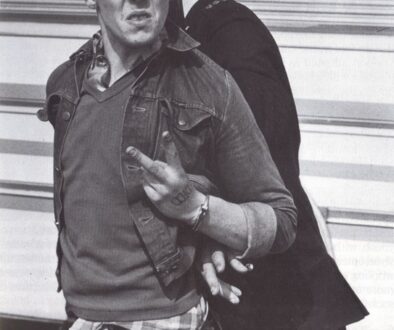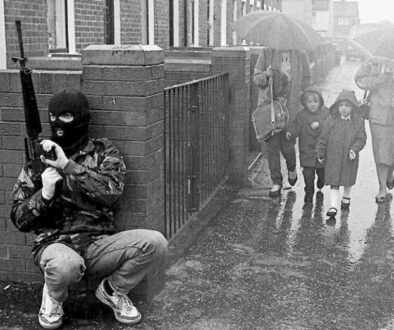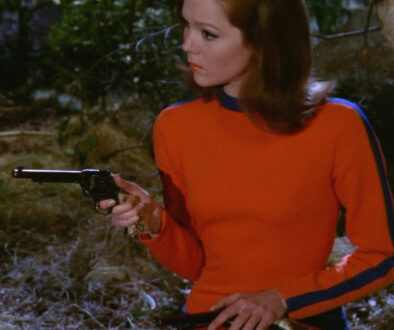An Unused Can of Monster’s Cat Food (The Last War in Albion Part 16: Maxwell the Magic Cat, The Stars My Degradation)
| Figure 123: A late Maxwell the Magic Cat strip that plays with the formal constraints of the comic medium (Alan Moore, as Jill de Ray, 1986) Click to expand. |
Before long any resemblance between Maxwell the Magic Cat and a children’s comic was gone, and eventually the Northants Post conceded the point and moved the strip off the children’s page entirely. It’s not that the strip was ever child-unfriendly as such, though after a few months it becomes hard to imagine any child particularly enjoying the jokes about pairing red wine with fish or Robert Mitchum. By the time Moore got to tins of cat food sitting on death row and the tragic end of Liver Chunks in Oyster Sauce any pretense that the strip was aimed at children was firmly out the window. Instead Moore turned the strip into a general gag-a-week strip that wandered through any number of interests: politics, complex formal play with the structure of the comics medium, bleak existential jokes (a captured mouse asks Maxwell what happens after death, and Maxwell describes cat heaven.The mouse admits that this doesn’t sound that bad, and asks where mice go when they die. “Oh, they go to cat heaven as well.”), and, of course, wonderfully dreadful puns. (Maxwell 4 page 30 for formally complex strip)
 |
| Figure 124: Alan Moore’s acerbic commentary on the Falklands War (Alan Moore, as Jill de Ray, 1982) |
By and large, this worked. Moore’s intensely structural approach lends itself well to comedy. This is something that even a cursory examination of interviews with him reveals: he is a terribly funny man. Even when Moore is working with a bit of a shaggy dog punchline he frames it in a precisely worked set of comic beats. Maxwell the Magic Cat isn’t spectacularly drawn, but it’s reliably funny. Even when it gets political, it does so with the sort of mass market subversiveness that characterizes classic American newspaper strips of the same era like Doonesbury and Bloom County – it’s cheeky, but never over the line of what can be published in a community newspaper. Moments like Moore’s suggestion that laws regarding inbreeding don’t apply to “cats and the Royal Family” might generate an angry letter or two, but it’s not like he was including satanic imagery and blasted skeletons. The edgiest the strip ever got was a ten week series satirizing the then-current Falklands War, in which a storyline about redundancies resulting in supporting characters being given their notice is derailed by a sudden and arbitrary cat/mouse war that causes everyone to forget about the unemployment crisis. Clever stuff, certainly, but given that Moore was busy launching V for Vendetta at the same time, it’s hard to suggest that it’s particularly incendiary.
| Figure 125: A cat. |
As mentioned, Maxwell the Magic Cat ran until late 1986. The official word in Acme Press’s second volume of collected Maxwell strips is that “Moore dropped the strip due to the pressure of other work, and the Post’s stance on homosexuals’ place in the community. It didn’t feel there should be one.” Both of these reasons are largely believable. Certainly Moore’s workload by 1986 was such that he probably was looking for an excuse. Equally, Moore’s passion on the issue of gay rights is documented (AARGH! came out just two years after he quit Maxwell), as is his propensity for taking decisive action over at times esoteric moral principles. It is also perhaps telling that the well of interesting ideas for Maxwell was visibly drying up towards its end. As the comic wore on the frequency with which Moore put out strips based on fairly pedestrian puns and rather flat gags. One strip consists of Maxwell sniffing a female cat for three panels and then asking if she’s a Sagittarius. As this is only four panels, an opening panel consisting of Maxwell standing and whistling is added to bring it to five. Also, “Sagittarius” is misspelled. But even towards the end there were gems – three weeks later Moore has a particularly clever iteration of his frequent swipes at his own drawing ability.
 |
| Figure 126: Maxwell the Magic Cat was collected in four issues by Acme Press in the mid-80s – its only reprint to date. |
The answer proposed by Eddie Campbell in the first Acme collection is likely a lot of it. Maxwell provided Moore the opportunity for “immediate representation of [his] thoughts and idle notions; many samples are throwaway ideas, playful jokes about the technicalities of comics – balloons, frames, title-headings – but they reach us without being modified by a collaborator or the complicated requirements of the big publishing houses, nor are they spoiled by the accompanying tiresome acrimony of the soured involvements of the smaller publishing houses.” Or, as Moore put it more simply in a 1991 interview, “Maxwell The Cat was fun, though. I carried on doing it long after it was profitable for me to do so.”
But in many ways there is an even simpler explanation for Moore’s strange perseverance with the strip: it was for his local paper. Moore has, throughout his career, maintained active connections with the local community of Northampton, from his Arts Lab work in the mid-70s through to Dodgem Logic’s endearingly commercially naive localism. It is not, to be clear, that the strip gave him some sort of practical power in the community. apparently the only reader comment he ever got came four years into the run, and mistook the Jill de Ray pseudonym as a real person and declared her a “frustrated old bitch,” which Moore sardonically comments seemed “scarcely fair considering I’d only just turned thirty at the time.” Rather, it seems to be the basic virtue and value of writing something for and about his local community. That someone who would go on to pen a 750,000-word novel about a small portion of Northampton would persist in penning a comic strip for the local paper as long as his ethics allowed hardly seems surprising. To quote Moore, “it’s quick, disposable, and enables me to respond quickly on a local level to anything I feel like mouthing off again,” describing it as “not so much a comic strip, I suppose, but more a primal scream session.”
This is, in many ways, what is most significant about Maxwell the Magic Cat within Moore’s oeuvre – the degree to which it marks him as a very different sort of comics creator. Maxwell the Magic Cat is not some passion project for Moore. Its value was not the extent to which he loved doing it, but rather the extent to which it provided a material engagement with the local world around him. In this regard his eventual departure from the strip was wholly consistent with the strip: a howl of rage embedded firmly in the local community.
 |
| Figure 127: Savage Pencil’s Rock ‘n Roll Zoo was the other comic featured in Sounds alongside Moore’s early work. |
The other substantial work of Moore’s that falls into this early period is The Stars My Degradation, the second and far longer-running of his two Sounds strips (although he did a handful of one-offs for the Christmas issues of Sounds, all but one of these were in the same setting as The Stars My Degradation). On one level The Stars My Degradation is a clear transitional work between Moore’s earliest work on Roscoe Moscow and Maxwell the Magic Cat and the later sci-fi/fantasy/horror work for which he’s known. On the one hand it’s still in the underground style of Roscoe Moscow, the strip it directly replaces. On the other, it’s a sci-fi strip. Where Roscoe Moscow was based on Moore’s assessment of what Sounds wanted (presumably based largely on the strip he was accompanying on the Sounds comic page, Savage Pencil’s Rock ’n Roll Zoo), and Maxwell the Magic Cat was devised in response to a specific commission, The Stars My Degradation is the first time in Moore’s professional work that he’s gotten to shape a comic to his own interests. And those interests are sci-fi. In this reading, The Stars My Degradation retains the underground styles of Roscoe Moscow, but introduces the sci-fi style Moore will eventually gravitate towards.
The problem, of course, is that the chronology of Moore’s career doesn’t support that at all. As noted, by the time The Stars My Degradation started Moore had already begun work for Doctor Who Magazine, with his first story, “Black Legacy,” wrapping around the same time as Roscoe Moscow. Within a few months of its beginning Moore would begin work for 2000 A.D., and while working on The Stars My Degradation he’d do his work with Star Wars, and begin his work for both Marvel UK and Warrior. The Stars My Degradation is, in other words, not a transitional strip, but something Moore undertook while already in the process of switching from his initial career as a writer-artist to a career primarily as a writer. Further complicating this transition is that the end of The Stars My Degradation wasn’t even written by Moore – as of 1982 he was only doing art chores on the strip with the writing done by the pseudonymous Pedro Henry.
 |
| Figure 128: Alan Moore saving time in The Stars My Degradation (Alan Moore, as Curt Vile, 1981) |
Where Roscoe Moscow demonstrates Moore pushing himself, The Stars My Degradation consistently feels safer. This becomes clear almost immediately: where Moore challenged himself with increasingly elaborate title splashes, every installment of The Stars My Degradation used a consistent vertical band with a brief comedic rhyme: “Dempster Dingbunger is my name / Sputwang is my nation. / The depths of space gob in my face…”, with the strip’s title completing the verse. Similarly, Moore largely abandons the complex and ambitious layouts and structures he employed in Roscoe Moscow for a simpler and more direct sort of storytelling, occasionally punctuated by jokes about how he’s blowing his deadlines or strips that are self-evidently constructed so as to allow him to hit them with minimal effort, such as a strip consisting of five tight close-ups of characters faces with lengthy captions providing their thoughts.
In this regard The Stars My Degradation feels less like an artistic transition and more like a comics writer trying to scrape a living together. When he started it his Sounds work was still the bulk of his income – the ten quid Maxwell the Magic Cat was making him was a necessary supplement, and whatever he’d made off of his eight pages of Doctor Who work would have been little more than a nice bonus. The sci-fi conceit put the comic closer to Moore’s own interests than Roscoe Moscow was, but the overall impression is of Moore making time while he waits to get established doing what he had by this point realized he should be doing, namely writing strips for other artists to draw.
 |
| Figure 129: Alan Moore crafts an S. Clay Wilson-esque tableau featuring cameos of his other characters in The Stars My Degradation (Alan Moore, as Curt Vile, 1981) |
That is not to say that The Stars My Degradation lacks interesting moments. Moore occasionally embraced structural complexity in The Stars My Degradation, and there are several strips he clearly spent time on, most notably a single panel fight scene in the mould of his S. Clay Wilson tribute in Roscoe Moscow, this one including his parody of Marvel Comics’s X-Men alongside cameo appearances from Roscoe Moscow, St. Pancras Panda, Maxwell, and his recurring 2000 A.D. character Abelaard Snazz. He frequently had clever plots as well, particularly early on – for instance, a plot in which murderously psychotic cyborg Axel Pressbutton infiltrates an anarchist cell consisting entirely of police informants trying to infiltrate an anarchist cell. This culminates in one informant, depicted as a stereotypically masked anarchist with a wide-brimmed hat, seen, in his first appearance, actually clutching a lit bomb, having his intended to be impossible plan to blow up the Central Justice Building come off, resulting in the revolution actually taking place.
But in the end, where Roscoe Moscow felt like early work of someone with vast capabilities in their craft, The Stars My Degradation feels like a man getting paid. It is, of course, impossible to take this as a significant criticism. Artistic production is first and foremost a form of work and labor. Moore was a working artist trying to feed a family. By the time he started on The Stars My Degradation he had one kid, and his second was on the way. To criticize him for “merely” doing a comic for the fact that it kept his family from starving is to miss the fact that the War is not merely an abstracted phenomenon of textual play, but a real sequence of events that happened to actual people. In this regard The Stars My Degradation marks the point where Moore manages to accomplish what Morrison failed to in all of his inventive juvenilia: to turn out “good enough” material on a regular enough schedule to make a living doing it, and to demonstrate the discipline needed to do so past the point where the work is fun or intellectually satisfying. To continue to come up with inventive page layouts and subversive cat gags week in and week out is one thing. To labour excessively on a reasonably humorous sci-fi parody strip in order to cover up inadequate artistic skills is another. [continued]





November 2, 2013 @ 8:35 am
collected in four issues by Acme Press in the mid-80s – its only reprint to date
Hmm, I have a reprint somewhere that doesn't look like that one. Maybe it's a different issue. It's red or orange.
November 2, 2013 @ 8:44 am
Yeah, that's probably volume 1 of the Acme reprints.
November 2, 2013 @ 8:51 am
Damn, I vaguely thought I had the whole run.
November 2, 2013 @ 8:52 am
The art from The Stars My Degradation looks to me like a conscious imitation of Starlin.
November 2, 2013 @ 9:02 am
For example:
http://24.media.tumblr.com/tumblr_m3zy0v68sW1qc9vexo1_500.jpg
http://www.threeriversonline.com/warlock15big.gif
http://3.bp.blogspot.com/-rlZnzTPX7gs/T8bPTv-UjBI/AAAAAAAAEhE/JT4s6uhwKLo/s1600/Warlock-14p.jpg
http://farm4.static.flickr.com/3585/3540864863_92aee1a8f8.jpg
November 2, 2013 @ 9:10 am
Interesting, and good catch. Inasmuch as that's the case – and I agree – it seems to be on the level of panel framing as opposed to style (which is basically unchanged from Moore's earlier work). It's got an extended X-Men parody in it, so the Starlin style is likely deliberate as well. We'll see if I have time to bang out a paragraph or two between now and Thursday on it.
November 2, 2013 @ 9:19 am
it seems to be on the level of panel framing as opposed to style
Agreed for most of them, but I think the first image I linked shows similarity of style too.
November 2, 2013 @ 9:30 am
A few more examples, all from Captain Marvel #32, which has the distinction of being the first Marvel comic I ever bought (which is why this imagery is so engrained in my memory):
http://1.bp.blogspot.com/-_L_ze0lnzmc/UbDD4Lu7YaI/AAAAAAAAM4U/PMeq63Fr-9Q/s1600/CaptMarvel320010.jpg
http://3.bp.blogspot.com/-4ZwjPOKtSLE/UbDD1lQ087I/AAAAAAAAM3k/sPjX0BkAO_8/s1600/CaptMarvel320004.jpg
http://dcomixologyssl.sslcs.cdngc.net/i/10547/40339/c49629680d59fccb7093670f354b0b9d.jpg?h=cefa4fb5f87d8c771e14fbc59c5afacc
http://4.bp.blogspot.com/-NE8XYlhg0vM/TXVQL0BtcdI/AAAAAAAAEMA/KfBibscpLcc/s320/Captain_Marvel_32-18.jpg
November 2, 2013 @ 10:18 am
"Red wine with fish… well, that should have told me something."
November 2, 2013 @ 10:31 am
Is the title a homage to or a parody of the Alfred Bester novel?
November 2, 2013 @ 10:39 am
Gully Foyle is my name,
Terra is my nation.
The depths of space my dwelling place;
The stars my destination.
(More on this next week)
November 2, 2013 @ 11:57 am
I say it's a coincidence. That's my story and I'm stinking to it.
November 2, 2013 @ 12:13 pm
I certainly can't imagine any relationship between an sf novel with a working class protagonist plus an early rape scene, and the work of Alan Moore. (Parsing problems: I was asking what was the relationship, rather than whether there was a relationship at all. Will find out answer next week.)
November 2, 2013 @ 10:50 pm
Terry is my Nation. Oh wait, this isn't the Eruditorum, is it?
November 3, 2013 @ 7:53 am
With Moore's work the line between homage and parody can be fuzzy.
November 3, 2013 @ 6:15 pm
My general impression of Maxwell the Magic Cat (of which I've only read a smattering of strips) is actually quite different. Moore is undoubtedly a funny man, and while few of his long form works are strictly comedic, his sense of humor comes across in much of it in some form or another. But he's really ill-suited to the four panel strip format. A lot of MtMC is clever, some of it is passably amusing, but fairly little of it is actually funny. It feels abridged, like Moore is struggling to fit his observations into four panels and noticeably chafing at the limitation.
It's not awful, per se, and it's arguably better than much of what gets published in American newspapers (not a huge hurdle to leap over, mind you). But it's not particularly good, either, and if not for its historical interest as one of Moore's formative works, it wouldn't be memorable at all.
November 4, 2013 @ 12:31 am
He frequently had clever plots as well, particularly early on – for instance, a plot in which murderously psychotic cyborg Axel Pressbutton infiltrates an anarchist cell consisting entirely of police informants trying to infiltrate an anarchist cell.
Moore got this plot from G. K. Chesterton's The Man Who Was Thursday: A Nightmare (1908). But it's such a brilliant idea that it deserves to be recycled.
November 4, 2013 @ 1:00 am
Just a quick note to say that the pseudonymous Pedro Henry was Moore's longtime friend Steve Moore (no relation). Steve wrote the first appearance of many of the characters from The Stars My Degradation in Three Eyes McGurk and His Death Planet Commandos, which appeared in Rip Off Comix #8 in 1981, which was drawn by Alan.